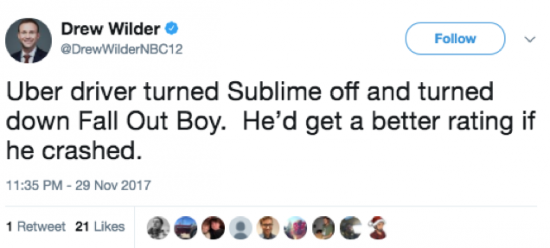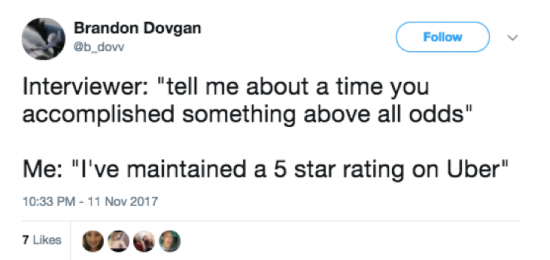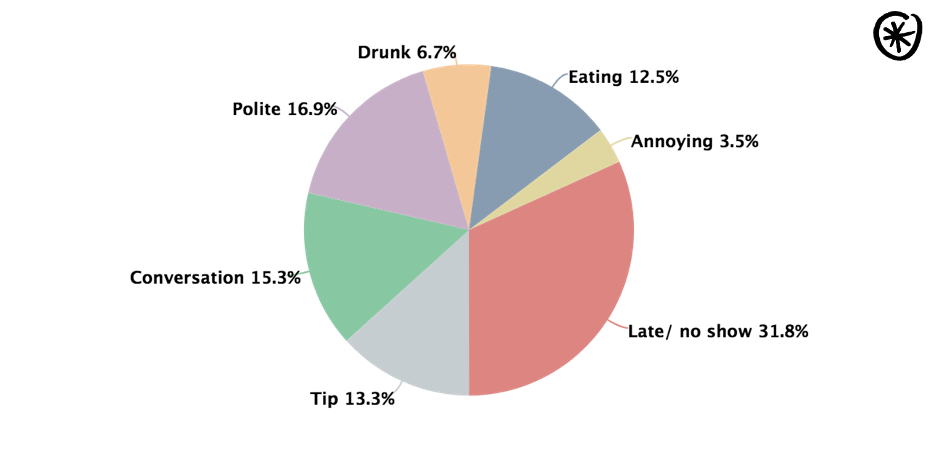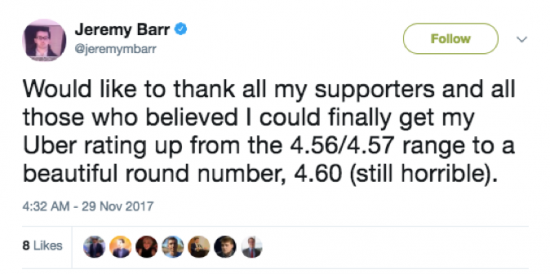What’s your score? How Uber’s rating system inspires emotional engagement
Online ratings systems are an undeniable ego-rub. Consumers rating one another is nothing new and reviews of individuals have been a staple feature on sites such as Amazon and eBay for years. But Uber ratings are something else.
Uber's scores out of five - for both drivers and riders, based on face-to-face interactions - are taking the rating system outside of the transaction shopping context and into the wider world of pop culture.
From cropping up in Tinder and Twitter bios to saving you in an awkward dinner party scenario, an Uber rating is a relatable reference. This Bloomberg article even invites Uber users with the rating 4.7 and below to seek an assessment of their behavior from friends and family, suggesting their rating reveals something deeper about who they really are. Queue the Black Mirror references.
So why are Uber ratings gaining this degree of cultural importance, and should other brands be paying attention? We had a look at the social conversation around the subject to find out.
Off the charts
A quick look at Google search data reveals the volume of searches around “Uber ratings” growing at a faster rate than eBay or Amazon review terms.
Search interest peaks in January 2016. This spike is likely a result of the 'Five Stars' Saturday Night Live sketch featuring Aziz Ansari, in which he plays a rider desperate to improve his 3.9 score during his next trip at any cost necessary (including giving a driver a back rub).
The frequency of people searching for Uber ratings on Google has since been decreasing.
However, a different picture is revealed by looking at Twitter data (above). eBay and Amazon ratings discussion is virtually non-existent, but the conversation about Uber ratings has been growing during the past couple of years and isn’t showing signs of subsiding, emphasizing that it remains a relevant discussion topic.
What are people rating one another for?
When it comes to riders rating drivers, they tend to report giving a five-star rating, unless something goes really wrong.
There is, however, one factor that appears to be more of a deal-breaker than actual driving skills: their driver’s music choice.
Overall, though, rating drivers is not top of riders’ minds, with less than a quarter of the conversation focusing on this. It is, perhaps predictably, their own rider rating that app users are eager to discuss.
Achieving a high score is a source of pride for many:
Scores which riders perceive to be low, on the other hand, trigger a sense of frustration and confusion. App users try to figure out the reasons behind their scores going down.
Being late or cancelling is cited as the biggest offense, followed by the debate around whether starting a conversation with the driver helps or hinders one’s score. Worries over being polite enough, tipping, eating in a car and being drunk, or simply “annoying” all feature within the conversation as well.
Of course, expressing of a sense of extreme pride for a high score, or being “devastated” about a low Uber rating might be largely exaggerated. However, the fact that these jokes are recurring and relatable confirms that many people see Uber ratings as - at least somewhat - a wider reflection on who we are, and can shake a sense of identity, even for a moment.
But does your rating increase your brand loyalty?
So what are the implications of the rating system when it comes to the consumer brand-relationship between riders and Uber? Does receiving a score which a rider feels is an inaccurate reflection on themselves trigger one to turn away from the brand? It seems like a high-risk strategy, to have users possibly feel inadequate while using the app.
But riders’ posts suggest it’s unlikely. While they may be disillusioned with their score, many work hard to “fix it”, or sustain the score they are happy with, even if it requires effort.
What could be the reasons behind this? According to the recent study from the Harvard Business review, there is a set of emotional motivators brands can leverage in order to get consumers more emotionally invested.
These motivations include consumers’ desire to stand out from the crowd, feel a sense of belonging and living up to one’s ideal self-image. Having a perfect Uber rating, arguably, taps into all of these, resulting in a high degree of emotional investment.
Working to improve one’s rating can also be tied to the sociological concept of the “ the escalation of commitment”. This is a phenomenon where a person or a group will continue investing effort into something that already has had a negative consequence.
In this case, one might continually care about their Uber rating and work on it, even if they don’t believe the rating system to be fair or realise them caring isn’t rational, simply because they have previously already invested time and effort into their relationship with the brand.
What's next?
Today brands increasingly thrive for a two-way dialogue with consumers, in order to truly connect with them. Some of the ways they try to achieve this connection is through reaching out to consumers directly on social media and creating unique collaborative experiences, where consumers get to contribute to the crafting of the brand’s identity.
Perhaps, through creating an eco-system where the interaction between riders and the drivers - who represent the brand during the ride - become so important, Uber scores an ultimate jackpot when it comes to stimulating this brand dialogue, and, most importantly, emotional investment. People want to use the app to improve their rating, guaranteeing business.
We're not suggesting all brands should seek to introduce rating systems, and this is where of course the Black Mirror comparisons would become all too real. However, testing unconventional opportunities to stimulate consumer-brand dialogue can go a long way in inspiring emotional engagement.








